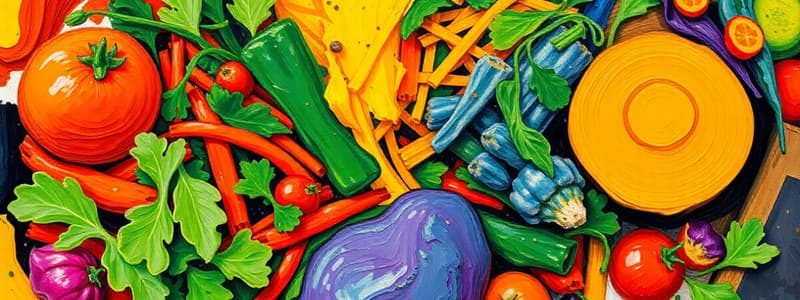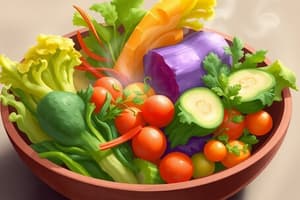Podcast
Questions and Answers
What is the primary reason for labeling canned vegetables with a date?
What is the primary reason for labeling canned vegetables with a date?
- To know how long the food will be at its best quality (correct)
- To prevent accidental opening
- To track the number of cans available
- To indicate the nutritional value
Which cooking method is most suitable for less tender poultry?
Which cooking method is most suitable for less tender poultry?
- Roasting
- Moist heat method (correct)
- Dry heat method
- Deep frying
What is the least used moist heat cooking method for poultry?
What is the least used moist heat cooking method for poultry?
- Braising
- Steaming
- Boiling (correct)
- Simmering
What does the dry heat method primarily rely on for cooking?
What does the dry heat method primarily rely on for cooking?
Which method combines both wet and dry heat cooking techniques?
Which method combines both wet and dry heat cooking techniques?
Why should stuffing of poultry be done immediately before roasting?
Why should stuffing of poultry be done immediately before roasting?
Which of the following is a characteristic of simmering?
Which of the following is a characteristic of simmering?
What is the main benefit of steaming as a cooking technique?
What is the main benefit of steaming as a cooking technique?
What is the recommended approach to seasoning vegetables?
What is the recommended approach to seasoning vegetables?
Which characteristic is NOT a standard for judging vegetable quality?
Which characteristic is NOT a standard for judging vegetable quality?
What is the primary guideline for food presentation mentioned?
What is the primary guideline for food presentation mentioned?
How should fresh potatoes and onions be stored?
How should fresh potatoes and onions be stored?
Which cooking technique describes cooking vegetables in a small amount of fat over high heat while tossing them often?
Which cooking technique describes cooking vegetables in a small amount of fat over high heat while tossing them often?
What is the appropriate way to store frozen vegetables?
What is the appropriate way to store frozen vegetables?
What should be avoided for effective food presentation?
What should be avoided for effective food presentation?
Which statement about vegetable texture is correct?
Which statement about vegetable texture is correct?
What should not be used when cooking green vegetables to maintain their color?
What should not be used when cooking green vegetables to maintain their color?
What is the recommended cooking technique for vegetables that need to be prepared ahead of time?
What is the recommended cooking technique for vegetables that need to be prepared ahead of time?
What is the effect of overcooking vegetables?
What is the effect of overcooking vegetables?
Which vitamin-rich vegetables are suitable for a cooking method that retains more color?
Which vitamin-rich vegetables are suitable for a cooking method that retains more color?
When should vegetables generally be cooked in relation to service time?
When should vegetables generally be cooked in relation to service time?
Which cooking method is preferred for strong flavored vegetables?
Which cooking method is preferred for strong flavored vegetables?
What should be avoided to ensure even cooking of vegetables?
What should be avoided to ensure even cooking of vegetables?
Which type of vegetables should be treated with acid to prevent browning?
Which type of vegetables should be treated with acid to prevent browning?
Flashcards
Poultry Cooking Methods
Poultry Cooking Methods
Different ways to cook domesticated birds (like chickens, ducks) for food, categorized by moist heat and dry heat.
Moist Heat Cooking
Moist Heat Cooking
Cooking food using liquid or steam. Good for tenderizing tough meats.
Simmering
Simmering
Cooking food in hot liquid just below boiling point.
Boiling
Boiling
Signup and view all the flashcards
Steaming
Steaming
Signup and view all the flashcards
Dry Heat Cooking
Dry Heat Cooking
Signup and view all the flashcards
Roasting/Baking
Roasting/Baking
Signup and view all the flashcards
Storage of Canned Vegetables
Storage of Canned Vegetables
Signup and view all the flashcards
Fat-Rich Vegetables
Fat-Rich Vegetables
Signup and view all the flashcards
Carbohydrate-Rich Vegetables
Carbohydrate-Rich Vegetables
Signup and view all the flashcards
Protein-Rich Vegetables
Protein-Rich Vegetables
Signup and view all the flashcards
High Moisture Content Vegetables
High Moisture Content Vegetables
Signup and view all the flashcards
Julienne
Julienne
Signup and view all the flashcards
Batonnet
Batonnet
Signup and view all the flashcards
Overcooking Vegetables
Overcooking Vegetables
Signup and view all the flashcards
Cooking Green Vegetables
Cooking Green Vegetables
Signup and view all the flashcards
Vegetables: Color
Vegetables: Color
Signup and view all the flashcards
Vegetables: Appearance
Vegetables: Appearance
Signup and view all the flashcards
Vegetables: Texture
Vegetables: Texture
Signup and view all the flashcards
Vegetables: Flavor
Vegetables: Flavor
Signup and view all the flashcards
Seasoning Vegetables
Seasoning Vegetables
Signup and view all the flashcards
Storing Potatoes & Onions
Storing Potatoes & Onions
Signup and view all the flashcards
Storing Frozen Vegetables
Storing Frozen Vegetables
Signup and view all the flashcards
Storing Dried Vegetables
Storing Dried Vegetables
Signup and view all the flashcards
Study Notes
Vegetable Preparation and Cooking
- Vegetables are plants used as food, often accompanying meat or fish.
- Types of vegetables include: fat-rich (nuts, seeds, avocados, olives); carbohydrate-rich (seeds, roots, tubers); protein-rich (beans, peas, legumes); and high-moisture (tomatoes, radish, mushrooms).
- Key components in vegetables include fructose (sweet), glutamate (amino acid), carotenoids (yellow/orange/red pigments), anthoxanthin (white/pale yellow), and anthocyanin (red/blue/violet pigments).
- Washing and soaking are crucial for preparing vegetables; treat those that brown easily with acid (e.g., potatoes, eggplants).
- Common vegetable cutting methods include julienne (thin strips) and batonnet (small square shapes).
- Cooking vegetables affects texture, water content, color, and nutrient composition.
- Moist heat cooking (e.g., boiling) gelatinizes starch, while dry heat cooking (e.g., roasting) dextrinizes starch or caramelizes sugars.
- Protein in vegetables becomes more soluble and digestible with certain cooking methods, but vitamins (like vitamin C) may be destroyed by heat. Minerals can be lost to cooking liquid.
- Overcooking vegetables should be avoided; cook as close to service time as possible. If cooking ahead, slightly undercook and chill quickly for reheating.
- Avoid using baking soda with green vegetables.
- Cut vegetables evenly for even cooking; use salted water to boil green and other vegetables.
- Cook strong flavored vegetables uncovered; cook red/white in mildly acidic liquid to preserve color.
- Avoid mixing freshly cooked vegetables with vegetables previously cooked in a pan.
- Cooked vegetables should have natural, bright colors. Green vegetables should be bright green.
- Dishes should be attractively arranged on the plate. Textures should be crisp-tender.
- Vegetables like potatoes, squash, and tomatoes ideally have a smooth texture.
Avocado Preparation
- To prepare an avocado, slice it lengthwise around the pit, open it, carefully remove the pit, and scoop out the flesh.
General Cooking Techniques
- Sauteing: Quick cooking in a small amount of fat over high heat, tossing frequently.
- Pan-frying: Cooking in more fat over medium heat, without tossing.
- Braising: Slow cooking in a small amount of liquid.
- Baking: Cooking in a hot oven.
- Broiling/grilling: Cooking with direct heat.
Food Temperature and Presentation
- Serve hot foods on hot plates and cold foods on cold plates.
- Properly arrange food on plates, allowing space to enhance presentation; ensure portions are appropriate to each serving size.
Storage and Preservation
- Store potatoes and onions in a cool, dry, dark place; keep separate from fruits.
- Store frozen vegetables at a low temperature.
- Store dried vegetables in a tightly closed container in a cool, dry, and well-ventilated place.
- Canned vegetables should be stored in a cool, dry place.
Poultry Cooking
- Mature poultry is best cooked using moist heat methods, while young poultry is better using dry heat methods. Poultry stuffing should be done just before roasting.
- Basting helps enhance the flavor of lean poultry by adding moisture.
Cooking Methods (Additional Details)
- Simmering: Cooking in liquid just below boiling point.
- Boiling: Cooking in liquid at the boiling point.
- Steaming: Cooking using steam.
- Braising/Stewing: Combining dry and moist heats.
- Roasting/Baking: Cooking using hot air.
- Broiling/Grilling: Cooking with direct heat.
- Pan-Frying/Sautéing: Cooking in small amount of fat.
- Deep-Frying: Cooking in a large amount of hot oil.
Portion Sizes and Serving Sizes
- Portion is the amount of food an individual chooses to eat, which can be more or less than the serving size.
- Serving size is a quantified amount recommended on nutrition facts labels.
- Portion Distortion refers to increasing portions sizes that are considered "normal".
- To control portions, use measuring tools (cups, spoons, scales) and eat from plates instead of packages.
Food Safety (General)
- Keep raw poultry separate from other foods.
- Refrigerate cooked poultry at appropriate temperatures to avoid bacteria growth.
Studying That Suits You
Use AI to generate personalized quizzes and flashcards to suit your learning preferences.




